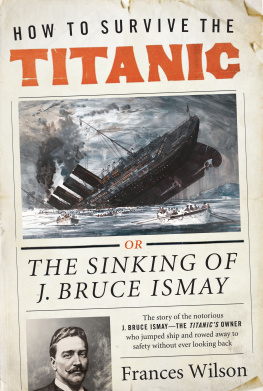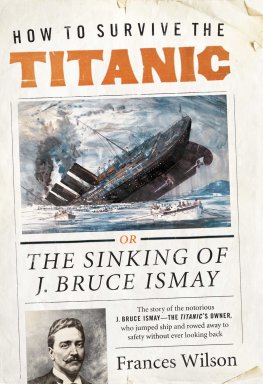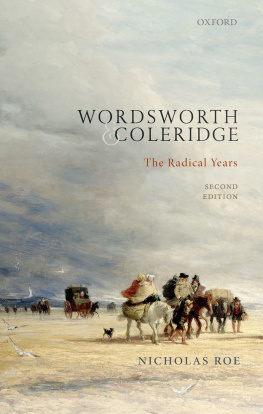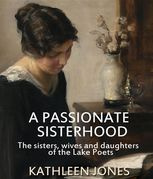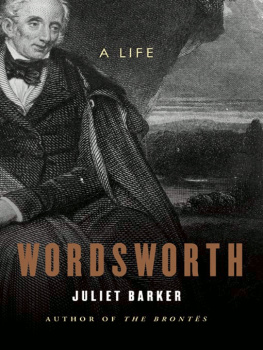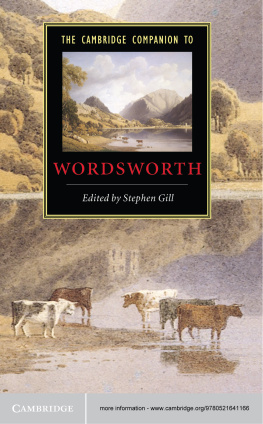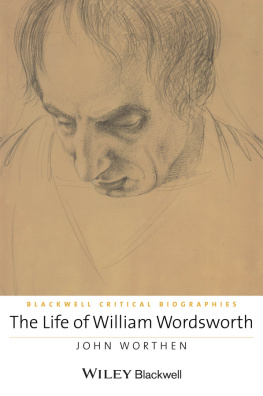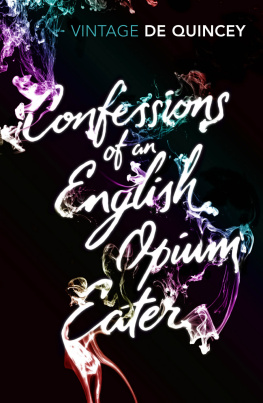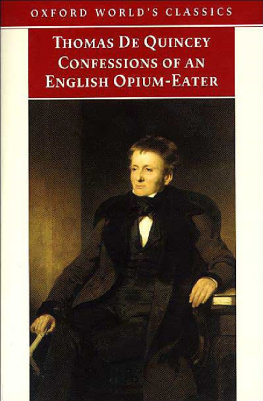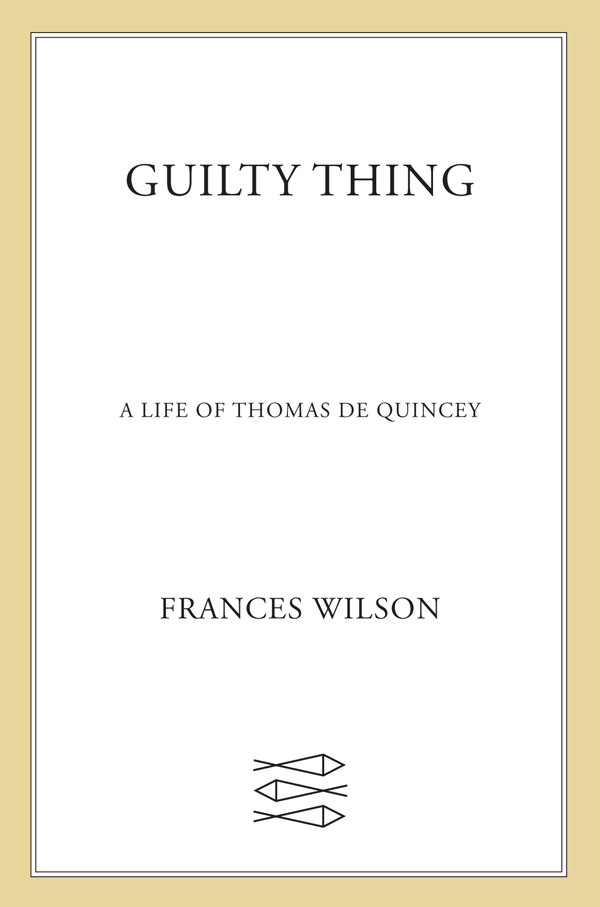Contents
Guide

The author and publisher have provided this e-book to you for your personal use only. You may not make this e-book publicly available in any way. Copyright infringement is against the law. If you believe the copy of this e-book you are reading infringes on the authors copyright, please notify the publisher at: us.macmillanusa.com/piracy.
For Quincy W.
it started like a guilty thing
Upon a fearful summons.
Shakespeare, Hamlet , Act 1, Scene 1
Blank misgivings of a Creature
Moving about in worlds not realised,
High instincts before which our mortal Nature
Did tremble like a guilty thing surprised
Wordsworth, Intimations of Immortality


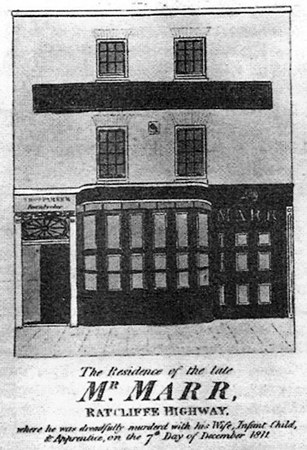
24 Ratcliffe Highway, a most chaotic quarter of eastern or nautical London.
Who knows the individual hour in which
His habits were first sown, even as a seed?
Who that shall point as with a wand and say
This portion of the river of my mind
Came from yon fountain?
Wordsworth, The Prelude, Book Second
A few minutes to midnight, 7 December 1811
Save for the quick light tap of Margaret Jewells footsteps on the cobbles, the Ratcliffe Highway had fallen silent. The publicans of Shadwell had poured their last pitchers, the sailors and stevedores had turned in to their boarding houses, the pawnbrokers, block-builders and rope-makers had bolted their doors. Black water sloshed against the steps of the Wapping wharves, and behind the wall of the London Docks the rigging of the ships creaked and swung. Margaret Jewell had been sent by her master, Timothy Marr of Marrs Silk, Lace, Pelisse, Mantle and Furr Warehouse on 29 Ratcliffe Highway, to buy a dozen oysters for his family supper and to pay the bakers bill. Trading continued late on Saturday nights, and Marrs drapery was only now closing.
It was the last day of the working week and the end of the year in which a comet had been seen falling through the sky. Napoleons Comet, as it was known in Europe, was held to portend unnatural times, and in William Blakes miniature vision, The Ghost of a Flea , it hurls through the night between embroidered stage curtains while a monstrous creature with the face of a murderer and the legs of a man whips his tongue into a bowl of blood. Beneath the comets luminous tail, America would be rocked by earthquakes and the Mississippi flow backwards; in England, those for whom comets were omens observed that the war with France had dragged into its twentieth year, the old, despised and dying King George had been once more declared insane by his doctors, and textile workers in Nottingham were smashing with hammers a thousand stocking machines. Samuel Taylor Coleridge, living through the worst days of his life, recorded in his notebooks a nightmarish version of the comets trajectory: Suppose the Earth gradually to approach nearer the Sun or to be scorched by a close Comet & still rolling on with Cities menless Channels riverless 5 miles deep.
Margaret Jewell made her way first to the oyster shop, but finding it already shut she turned around and headed back down the road towards the bakers. Marr had not yet put up the shutters on his freshly painted bay window his establishment had recently undergone a refurbishment and so she could see him as she passed by, standing at the counter on the ground floor with his young apprentice James Gowen, clearing away the rolls of cloth. Her route down Ratcliffe Highway took her past St George in the East, the most phantasmagoric and sinister of Hawksmoors six London churches, its 160-foot tower rising pale above the rooftops like a schooner riding a storm. Ian Nairn later called St George the hardest building to describe in London. It has the hypnotic pull of a pyramid, but resembles an entity like a hand or foot, total shape and total atmosphere. With its four pepper-pot turrets, each marking the position of a spiral staircase, St George takes us to a stage beyond fantasy and into the more than real world of the drug-addicts dream.
Immediately south of Margaret Jewells path lay the countrys largest landing stage. Every year 13,000 ships laden with goods arrived at the London Docks from India, Greenland, China and Australia. Before the docks were completed in 1806, the river had been log-jammed with 2,000 vessels at a time packing into a mooring space that could hold 500, their precious cargoes exposed to pirates. Not even the river police could control the rackets of thieves and receivers, and so a fortress-like wall, thirty feet high and defended by guards, was girdled around the ships. The architect, Daniel Asher Alexander, Surveyor to the London Dock Company, also built the Dartmoor and Maidstone prisons and his design for the docks was inspired by Piranesis semi-hallucinatory images of the Carceri dinvenzione , or Imaginary Prisons, etched in Rome in the late 1740s. The dock wall enclosed a citadel of merchandise, and the Ratcliffe Highway looked like a dwarf city on the other side. Vaults extending for acres beneath the streets stored Himalayan mounds of cocoa, tobacco, calico, indigo, muslin, wine, spices and coffee; as well as ostrich feathers, elephants tusks, rugs, ambergris, monkey skins and cages of exotic beasts. Once a Bengal tiger imported for display in an emporium on the highway escaped from its box in the warehouse and took off with a boy between its jaws.
Margaret Jewell walked that night through a theatre of immensity: giant ramparts, narrow passageways, fortresses, dungeons and flights of steps like Wapping Old Stairs, which led to the river that flowed out to the sea. The ocean was part of the lives of the shopkeepers, brothel-owners, landladies, publicans and laundresses who relied on the wages of the mariners who moored between berths. You could buy the largest oysters in England here, and shellfish scraped from the bottom of ships; even the vegetables had a scaly look.
The bakery had closed for the night and so Margaret Jewell returned home, having completed neither of her tasks. She had been out for no more than twenty minutes, she later said, but found the house closely shut up, and no light to be seen. I rang the bell, and no one answered. I rang repeatedly; whilst I was at the door, the watchman went by on the other side of the way. She rang again, more insistently, and this time heard through the keyhole the sound of footsteps on the stairs which she took to be those of her master, followed by the low cry of the Marrs baby.
The local watchman called the hour of one oclock, and told her to move on. I said I belonged to the house, she later explained, and thought it very strange that I should be locked out; he then observed that they had not fastened the pin of the window. The watchman himself now started hammering and John Murray, who ran the pawnbrokers next door, rose from his bed to discover the cause of the disturbance. Finding the girl locked out, Murray suggested that he might try the back entrance.
He climbed over the wall dividing the back yards of their two homes, and called out for Marr. The house remained silent but the door being open, Murray went inside. A candle burned on the first-floor landing; he went upstairs and, standing respectfully outside the bedroom door, called: Marr, Marr, your window shutters are not fastened. No sound came from the room and so Murray went downstairs; on opening the door which led to the shop he pushed against the body of James Gowen, whose face and head had been shattered by blows so severe that his brains had splattered across the counter and up the walls; Murray could see them hanging from the ceiling like limpets. Staggering backwards, he fell against Mrs Marr, her cranium fractured and throat cut, blood draining from her wounds. Murray stumbled to the front door which he opened, shrieking Murder! Murder! Come and see what murder is here! The watchman, Margaret Jewell and the neighbours, who had now joined them on the doorstep, crowded into the house. They found Timothy Marr lying face down behind the counter where, an hour before, Margaret Jewell had seen him standing. The child, wheres the child? somebody cried; there was a rush to the basement, where the baby lay floating in a cradle of blood, his head battered and his neck slashed.


